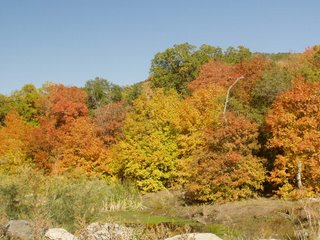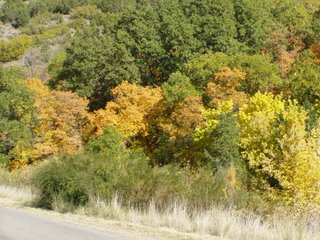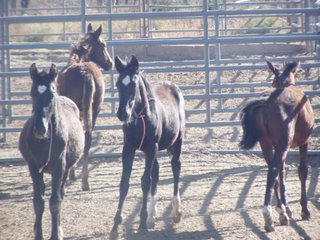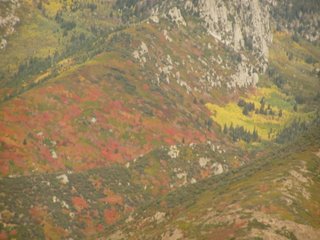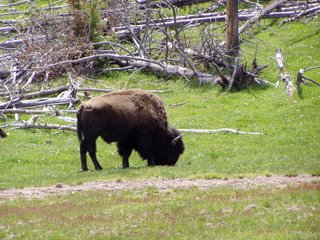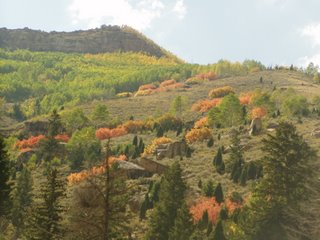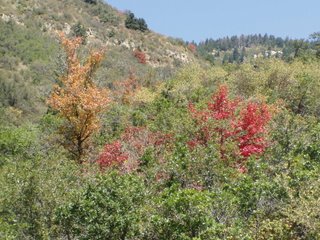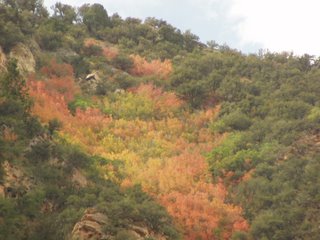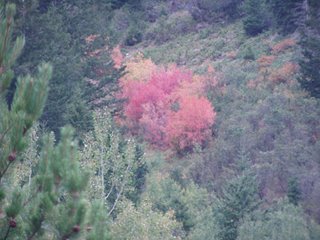Friday, September 29, 2006
THE OTHER SIDE OF SALT LAKE VALLEY

On the west side of the valley the mountains are not nearly as majestic.
There is a beautiful canyon called Butterfield Canyon on that side of the valley.
This canyon just happens to be the home of The Wild Horse Adoption Center.
This year they had at least 40 or more yearling colts.
The other part of the canyon we liked is the drive to the top.
This time of year this is one of the top drives to take for leaf peaking.
BEAUTIFUL SALT LAKE VALLEY
Salt Lake is in a valley between two Mountain ranges.
The east, Wasatch Mountains are very high and rugged, beautiful all fall and winter.
We feel really lucky to have this to look at every day out our windows.
Powered by Qumana
Wednesday, September 27, 2006
A ROMANTIC SYMBOL

If you want to see the romantic symbol of the American West-wild horses-Wyoming is the right state to do so.
Wyoming is not the largest populated state for them, Nevada is, Wyoming being the second largest. Vast deserts and unpopulated area’s make this a great state for wild horses.
Wild horses, part of the mystique of the Old West, are different from the domestic horse.
Mostly due to how they are bred. The domestic horses are line bred, to either be a quarter horse or a through bred in order to get certain characteristics of a particular breed.
Wild horses are bred through natural selection for survival. The traits that they have are the traits they need to survive out in the remote countryside.
Their legs and feet are usually bigger, thicker, and heavier than the domestic horses. If wild horses had thin spindly legs and thin feet, they would not survive very long. A broken bone would mean certain death. The rugged places that they live would not be suitable unless they were sturdy stock.
Wild horses have a lot of stamina and normally a little bit smaller than horses you see in the pastures.
Because of the 20% population growth in wild horses every year, the Government has set appropriate management levels for each area.
Every state with wild horses is required to round up and sell off all they can at an Adopt-A-Horse sale. That is how a lot of them get sold to meat packing plants for overseas meat markets.
The wild horses need a lot of room to roam and their range is about 20 to 30 miles per herd.
When looking for wild horses they are hard to see. They stay well away from where any people are.
There are still a few herds of Spanish Ancestry. There are a few of these original Spanish-type horses in southern Utah. When you see these beautiful horses you will know if they are wild or not. The wild horses have a different statute than the domestic. Always on guard, sniffing the wind, the stallion will round up the mares and colts defending them till death.
They are beautiful to watch but it is rare that you see any; if you do it is a rare treat. You should just stop and watch them before they are all gone.
We saw a small herd in the Mesa Verde, Colorado area last fall.
AN ELUSIVE MONSTER
Bear lake, Utah
Bear Lake is called the Caribbean of the Rockies for its intense blue water. It is the most striking of all lake colors. No one can agree on just what, that color is. Turquoise or cobalt blue, anything, but just plain blue.
The blue color is due to the light reflecting off the limestone particles, suspended in the water. Unlike the other lakes Bear Lake is the same color at all distances and angles.
Bear Lake is in northeast Utah, straddling the Utah, Idaho borders.
Bear Lake was named by early trappers who found the valley full of black bear.
It was a hunting and meeting place for the Native American tribes of the Shoshone, Bannock and the Ute.
In the early 1800’s mountain men like Jim Bridger, John C. Fremont and Jeddah Smith trapped for furs here.
It was settled by Mormon’s in 1860.
The elevation of Bear Lake is 5923 feet. It is 20 miles long and 8 miles wide with a depth of 208 feet.
It is rumored to have an elusive “Bear Lake Monster” It has never been captured.
This is the water sports paradise. Boating, sailing, jet skiing, and swimming.
The fishermen love it here. Bear Lake has 4 species of fish that can not be found anywhere else in the world.
Bonneville Cisco is the most well known.
In the winter the ice fishing is most popular. The Cisco comes close to the shoreline to span in mid-January. They can be dip-netted through a hole cut in the ice.
With 48 miles of shoreline this lake sees a lot of people enjoying themselves, winter and summer.
It is a beautiful drive in the early fall with the leaves turning colors.
They now have a new information center with photo taking platforms and picnic tables.
Bear Lake is called the Caribbean of the Rockies for its intense blue water. It is the most striking of all lake colors. No one can agree on just what, that color is. Turquoise or cobalt blue, anything, but just plain blue.
The blue color is due to the light reflecting off the limestone particles, suspended in the water. Unlike the other lakes Bear Lake is the same color at all distances and angles.
Bear Lake is in northeast Utah, straddling the Utah, Idaho borders.
Bear Lake was named by early trappers who found the valley full of black bear.
It was a hunting and meeting place for the Native American tribes of the Shoshone, Bannock and the Ute.
In the early 1800’s mountain men like Jim Bridger, John C. Fremont and Jeddah Smith trapped for furs here.
It was settled by Mormon’s in 1860.
The elevation of Bear Lake is 5923 feet. It is 20 miles long and 8 miles wide with a depth of 208 feet.
It is rumored to have an elusive “Bear Lake Monster” It has never been captured.
This is the water sports paradise. Boating, sailing, jet skiing, and swimming.
The fishermen love it here. Bear Lake has 4 species of fish that can not be found anywhere else in the world.
Bonneville Cisco is the most well known.
In the winter the ice fishing is most popular. The Cisco comes close to the shoreline to span in mid-January. They can be dip-netted through a hole cut in the ice.
With 48 miles of shoreline this lake sees a lot of people enjoying themselves, winter and summer.
It is a beautiful drive in the early fall with the leaves turning colors.
They now have a new information center with photo taking platforms and picnic tables.
Tuesday, September 26, 2006
WILD AND FREE

With all of the old west icons coming to an end, how much longer will there be wild horses?
The western states have had wild horses for hundreds of years.
Horses ran wild and free. You could drive out in the desert and watch them for hours. They ran in herds where one stallion had several mares. There were always colts with them. They were beautiful, proud animals.
If you lived in a remote area, a wild stallion might just steal you mare, from you. It happened a lot where I grew up in Idaho.
In my childhood we had many wild horses that were tamed and used as saddle horses on the ranch.
I had one when I was six years old. His name was Rocket. He lost his mother so when my Dad found him, he brought him home.
Rocket was so small he had to be fed with a baby bottle. He was a lot like the colt in this picture.
When he was old enough to go to the pasture with the other horses he was stolen. We called the Sheriff but we never did get him back.
They use to be wild and free, but today wild and free have restrictions.
They are rounded up by riders and helicopter each year. Some are taken from the herds for adoption and some sold for slaughter. They are sold to packing plants where they are prepared for human consumption in Europe, Asia, and other overseas markets.
Many Americans are opposed to slaughtering horses for any reason let alone for someone to eat. It is like eating the family pet.
Yet 85,000 horses are slaughtered each year.
There are adoption places in every area where you can go and view the horses. They will tell you about the adoption plan. We have one in the Salt Lake area in Butterfield Canyon, near Kennecott Copper Mine.
Utah ranks 35th in the nation in the number of farm and ranch horses, numbering in at 61,000. Just slightly fewer than Wyoming but four times more than Nevada.
I hate to see these, once free animals, not able to roam free any more. I guess I just oppose to change.
Monday, September 25, 2006
BISON IN THE CROSSHAIRS


With their shaggy coats and doleful eyes bison has long reigned as the icon of the American West.
North American bison, commonly called buffalo one roamed free in the west in staggering amounts.
The estimated 50 to 65 million roamed here in the 1800’s. Poaching and over hunting drove the buffalo to near extinction.
The only place now you can see one is in the Parks, zoos and private ranches.
They are making a come back through the efforts of these people. But this is causing a population problem in the parks. The amount of buffalo is swelling every year. The bison may become the first casualty of their own success.
Yellowstone National Park is having a bison hunt this year. It will be by drawing for a chance to kill and tag one.
The first round was last year and is already over where hunters shot 15 animals. That round will end January 15. Round 2 will start the next day and go through February 15.
It is a pilot effort, state wildlife officials are hoping to manage bison like they do other big game animals.
Opponents of the hunt say the hunt is unnecessary and cruel. The shooting of buffalo is unfair because they are a species that has no protected habitat outside Yellowstone National Park.
The hunt is very difficult to watch. When one buffalo is shot, the others in the nearby herd are affected too.
The mate will come over to the downed animal and try to lift the shot buffalo back onto its feet.
On the other side the wildlife management has no choice. They are required by law to manage these animals.
Will this be repeated this year? More than likely they tell me.The herd has to be thined out.
I think there should be many other and better ways.
Friday, September 22, 2006
Friday, September 15, 2006
SLOT CANYON THRILL


For your next thrill dont miss seeing this.
A narrow crevice cut through rock by wind and water over thousands of years.
Something you will not want to miss.
Located in Page, Az. on Navajo land by Navajo guide.
See Roger Ekis Antelope Canyon Tours.
You will not regreat doing it today.
See all of the pictures and complete story of our trip to the slot canyon on this doinstuff site under Antelope Slot Canyon
